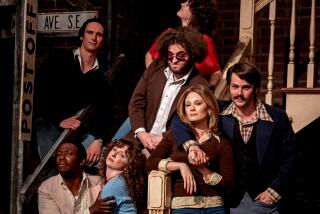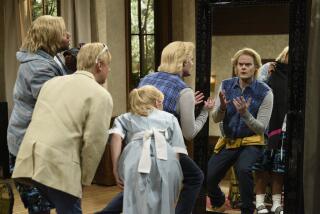A really big showman ...
- Share via
Fans of the nation’s top television talent showcases -- “American Idol,” “America’s Got Talent” and “Dancing With the Stars” -- may be shocked to learn that, for 23 years, one television show had the combined impact of those three smash hits. That weekly Sunday night extravaganza, “The Ed Sullivan Show” -- which left the air 40 years ago last month -- regularly created pop idols overnight, introduced unnoticed and unlikely talent, and featured fading stars who needn’t dance to justify their presence on the show.
Another stunning difference: “American Idol” draws about 30 million viewers for its grand-finale shows, whereas Sullivan attracted some 40 million viewers nearly every Sunday night for two decades -- when the country had half as many people as it does now.
There are more than faint traces of Ed Sullivan’s DNA in “Idol,” “Talent” and “Dancing.” Viewers who had never been to a Broadway show or a ballet, or heard an aria, encountered haute culture regularly on Sullivan’s show -- right alongside Borsht Belt comics, Chinese tumblers, dancing poodles, Marine drill teams, or the new middleweight champion of the world.
If Ed Sullivan had someone on his show, viewers figured, they must be significant. As Carol Burnett, a Sullivan find, put it, “When Ed Sullivan put his arm around you and said, ‘This is a very funny gal,’ all of American said, ‘This is a very funny gal.’ ”
The show is remembered now mainly for two of its 10,000 acts: the American TV debut of the Beatles, and Elvis Presley’s gyrations, which scandalized a then-easily scandalized country. But Sullivan’s show contributed far more than just those two historic pop moments during its lengthy reign at a time when all America watched the show every Sunday with their family, a national ritual and an early example of “appointment TV.” (It remains the longest-running prime-time live entertainment show in television history.)
Few then had heard of -- not to mention ever seen -- Burnett, the Supremes, Nat King Cole, Stiller & Meara, Jackie Mason, Eartha Kitt, Sam Cooke, Sammy Davis Jr., Phyllis Diller, Shelley Berman, Shecky Greene, Teresa Brewer, George Carlin, Keely Smith, Myron Cohen, Patti Page, et al. -- when Sullivan escorted them into our homes on his national stage. His eclectic taste and a lust for the family audience inspired him to trot out acrobats, elephant acts, ventriloquists, along with the regulation comics and singers -- plus, and perhaps most rarefied of all, little-known black performers.
Sullivan’s major legacy goes almost unmentioned now -- his trailblazing efforts to bring black artists to television at a time when it was unusual to see a black face other than an athlete on the small all-white screen on a major mainstream prime-time show. A few black megastars were allowed on TV -- Louis Armstrong, Bill Robinson, Duke Ellington -- but Sullivan regularly, and matter-of-factly, presented black entertainers he had seen at the Harlem clubs he routinely covered on his Broadway beat for the New York Daily News -- people such as Pigmeat Markham, Pearl Bailey, Aretha Franklin, from old-timers like dilapidated Moms Mabley to baby-faced newbies like Richard Pryor.
The show began modestly in TV’s infancy, 1948, and ran until 1971, when the rock ‘n’ roll juggernaut (and “Bonanza”) helped drive it off the air. When the show debuted as “Toast of the Town,” Sullivan was an aging Broadway columnist and ex-sportswriter, nearly 50, with no TV experience and three flop radio shows behind him.
Critics gleefully lambasted Ed’s wooden manner and jumbled intros, dubbing him “the Great Stone Face,” “the Toast of the Tomb,” “Cod-Eyes,” “Mr. Rigor Mortis” and the “Night of the Living Ed.” Observed comic Joe E. Lewis: “Ed Sullivan is the only man who brightens up a room by leaving it,” and Alan King bestowed this backhanded praise: “Ed Sullivan does nothing, but he does it better than anyone else on television.” New York’s leading TV critic, John Crosby, vilified Sullivan, writing that each weekend he asked himself “the same vexing question: Why is Ed Sullivan on television every Sunday night?”
Unlike the sleek hosts of today’s talent auctions, Sullivan further enhanced his clunky image by coming up with much-quoted gaffes, such as introducing singer Dolores Gray as “now starving on Broadway” and saying how pleased he was “to prevent opera star Robert Merrill.” He told a paraplegic war hero to stand and take a bow. He praised Jose Feliciano as “not only blind, he’s also Puerto Rican” (backstage he asked Feliciano if his guide dog did any tricks). He introduced “the late, great Irving Berlin.” Blanking out once on the Supremes’ name, he shouted, “Here they are -- the ... the ... the girls!”
For years, Sullivan was mocked and mimicked in the media until he wisely turned it all around by inviting impressionists on the show like John Byner and Will Jordan, who created the freeze-dried mumbler that people still remember. The mimics gave Sullivan a lasting identity and over time Ed endeared himself to viewers with his everyman uneasiness. He was TV’s first “reality” star who looked like the mug at the end of the bar.
Sullivan had his faults -- he was easily riled and got into public feuds he later regretted with stars and fellow columnists (scuffles with Jack Paar, Dick Clark, Hedda Hopper, Bette Davis, Ingrid Bergman, Jackie Mason).
Throughout his marriage he chased singers such as Phyllis McGuire, Sheila MacRae, Jane Kean and Monica Lewis. And the FDR Democrat with liberal sentiments caved into the Red scare by banning from the show blacklisted entertainers such as dancers Jerome Robbins and Paul Draper, comic Orson Bean, folksinger Leon Bibb and harmonica virtuoso Larry Adler. (He later apologized privately to a few banned performers.)
When it finally left the air on June 6, 1971, “The Ed Sullivan Show” was chucked out by CBS as part of a general housecleaning of programs considered not urban enough, heartland mainstays such as “Lassie,” “Mayberry R.F.D.,” “Green Acres” and “The Beverly Hillbillies.” Sullivan’s show came out of New York, and was heavily New York-centric, but after two decades CBS decided America had seen enough jugglers, dancing bears, divas, ballerinas, comics and crooners, no matter how famous or even cutting-edge (Mort Sahl, George Carlin, Janis Joplin, the Rolling Stones). By ‘71, TV had loosened up considerably and variety shows hosted by Garry Moore, Perry Como, Dinah Shore, Burnett and Sonny & Cher were presenting the same names Sullivan once had once featured exclusively.
By then, the entire nature of what constituted music, comedy and, indeed, entertainment and “popularity” itself had changed. The Sullivan show was no longer the gold standard of show business.
Rock and roll, which ironically gave the show a temporary second wind, led to its gradual undoing as the viewing audience split into factions and teens rebelled against their parents’ idea of entertainment.
Americans today wallow in 500 channels, but when Sullivan’s show debuted in 1948, most of America beyond the big cities was a primitive land, culturally. Only movies and radio fed the nation’s hunger for entertainment. For almost a quarter-century, Sullivan brought talent of every kind, both raw and refined, to the masses.
For better or worse, “The Ed Sullivan Show” helped shape the nation’s cultural taste and destiny.
--
More to Read
The complete guide to home viewing
Get Screen Gab for everything about the TV shows and streaming movies everyone’s talking about.
You may occasionally receive promotional content from the Los Angeles Times.






